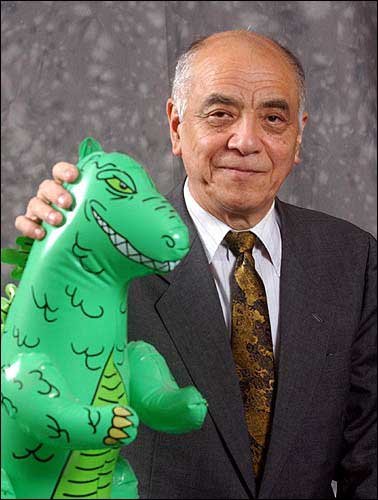YOSHIMITSU BANNO (Executive Producer) is the veteran Japanese filmmaker best known for the cult-classic “Godzilla vs. Hedorah” (1971, a.k.a. “Godzilla vs. The Smog Monster”), directing and co-writing the 11th film in Toho Company’s long-lived franchise, which began in 1954 with the eponymous original directed by Ishiro Honda.
Banno joined the Toho Company shortly after graduating from Tokyo University in 1955, studying at Toho under such directors as Hiromichi Horikawa, Mikio Naruse, Kengo Furusawa and Seiji Maruyama. He began his career as an assistant director, first working with the legendary Akira Kurosawa on four consecutive features—“Throne of Blood” and “The Lower Depths” (1957), “The Hidden Fortress” (1958) and “The Bad Sleep Well” (1960).
He continued as an assistant director on ten more features (many for filmmaker Furusawa) before making his own directorial debut on the 1970 feature, “Japanese Nature and Dream,” which played at Osaka's Expo 70 at the Mitsubishi Future Pavilion. Banno created a true audiovisual experience in the film, using mirrors to simulate the effects of earthquakes and volcanic eruptions, attracting record-breaking crowds.
The huge success and unique vision of Banno’s directorial debut led “Godzilla” series producer Tomoyuki Tanaka to enlist the filmmaker to help revitalize the series. The result, “Godzilla vs. Hedorah,” was a passionately avant-garde film born out of Banno’s visit to a severely polluted beach near the industrial area of Yokkaichi. Banno called his new monster Hedorah, taking its name from the Japanese word Hedoro, which means “mud.” Critics cited the film as one of the most unusual and unique in the series, mixing a blend of social satire, fighting monsters, animation, psychedelic imagery, split screens and musical sequences with death and violence.
After “Godzilla vs. Hedorah,” Banno realized the documentary “Starving Sahara” (1972), co-writing the screenplay for the film which depicted the severity of the drought in Africa. He next returned to the assistant director ranks with “Prophecies of Nostradamus” (Nosutodoramusu no Dayogen, 1974), adapted from the novel by Tsutomu Goto.
Over the next four years, Banno made a series of documentaries for the television program “Wonderful World.” In the early 1980s, he produced the Toho telefilm “Tokyo Earthquake M8” before writing and producing several animated films such as “The Story of Shigeo Nagashima,” “The Wizard of Oz” and “Techno Police” (Tekuno porisu 21C).
Banno also worked on the development of Japax, a shooting format and 70mm projection system similar to IMAX. He produced the first Japax film, “Breathe,” for the Tsukuba Expo in 1985. Further evolution led to Opax (70mm format projection screen dome), Cubic (3-D 70mm format) and Twin Cubic, which used dual Japax projectors.
Several films in various formats were presented at festivals and exhibitions throughout Japan. Those projects produced by Banno include “Magma Adventure” (1988), “Hurry Up Children of Earth” (1988) and “Eagle Fly” (1989). He also designed for the amusement park Space World, located in the city of Kitakyushu.
In 1989, Banno became an executive director in TOHO E・B Co. Ltd. and established Advanced Audiovisual Productions Inc., and became its President in 2001.







